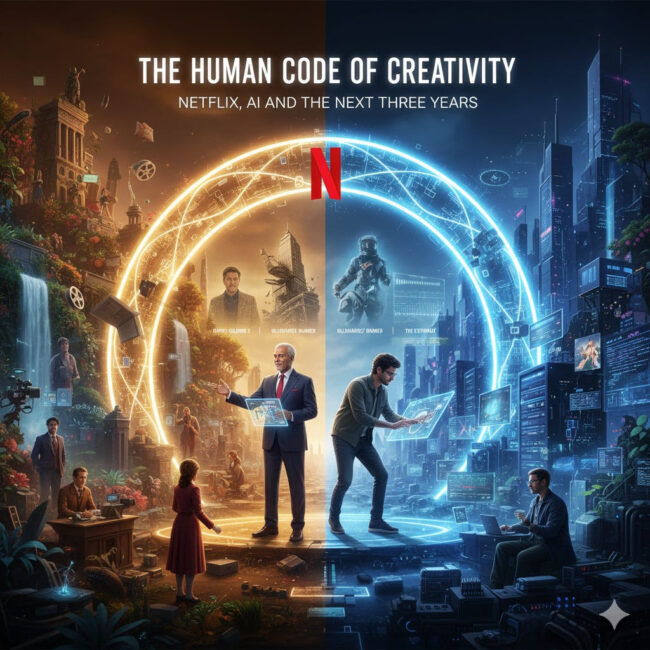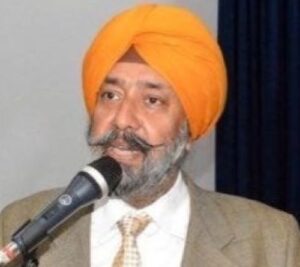 When Ted Sarandos, CEO of Netflix, addressed investors on 21st October 2025, his tone was equal parts confident and cautious. Artificial Intelligence (AI), he said, would empower creativity, not replace it. “AI can give creatives better tools,” Sarandos declared, “but it doesn’t automatically make you a great storyteller if you’re not.”
When Ted Sarandos, CEO of Netflix, addressed investors on 21st October 2025, his tone was equal parts confident and cautious. Artificial Intelligence (AI), he said, would empower creativity, not replace it. “AI can give creatives better tools,” Sarandos declared, “but it doesn’t automatically make you a great storyteller if you’re not.”
The statement sounds simple—almost self-evident—but behind it lies the central tension shaping Hollywood’s future: a race between technology’s accelerating capability and the irreducible mystery of human imagination.
Sarandos’s Real Message
Sarandos’s words were not just for analysts; they were a reassurance to artists. They came at a moment when writers, directors, and actors still bore the scars of the 2023 Hollywood strikes, which had drawn their red line around AI. Netflix, unlike most competitors, emerged from that confrontation with an unambiguous doctrine: AI will be used to augment, not automate.
Projects like Happy Gilmore 2, Billionaires’ Bunker, and The Eternaut illustrate this philosophy—de-aging actors, rendering impossible wardrobe sets, and creating complex building collapses that expand, rather than erase, human vision.
In effect, Sarandos was redrawing Hollywood’s moral contract. His message to storytellers was clear: We need you. Machines can help, but meaning still comes from the mind and heart. For an industry shaken by the fear of creative redundancy, that reassurance mattered deeply.
For Artists: The New Grammar of Creation
What Sarandos articulated was a new grammar of creation in the AI age. For artists, it means two simultaneous responsibilities: to stay human and to stay curious.
AI can simulate texture, generate dialogue, and even predict emotional arcs—but it cannot, at least not yet, care. The capacity for empathy, irony, moral judgment, and nostalgia—the invisible sinews of storytelling—remain human. Sarandos’s insistence that great storytelling is “a rare commodity” restores the dignity of creative labour in an economy obsessed with automation.
At the same time, his message carries a challenge. The future belongs not to purists who reject the machine, but to those who learn to dance with it. A writer who understands prompt-based ideation, a cinematographer who collaborates with generative scene builders, or a composer who bends AI models to express human longing—these will be the true auteurs of the coming decade.
Bilawal Sidhu’s Interpretation: The Three-Year Lens
Enter Bilawal Sidhu, the Austin-based creative technologist, TED AI Show host, and honorary Tech Advisor to The KBS Chronicle. His interpretation of Sarandos’s remarks is both sympathetic and surgical. He praises Netflix’s “augmentation-over-automation” philosophy as strategically wise—yet warns that “three years is forever in tech.”
Bilawal Sidhu calls Netflix’s stance the right play for now: a policy of maturity amid hysteria. But he reminds us that the half-life of technological advantage is shrinking rapidly.

He identifies two divergent paths before Hollywood:
The Netflix Path — integrate AI within existing production workflows, making VFX ten times faster and mid-budget projects visually spectacular; and
The Nuclear Path — start from scratch, generating entire films synthetically.
Today, he admits, the second path “looks like trash”—but give it 18 months and “some 22-year-old in their garage could ship the first AI-native show that makes traditional production look palaeolithic.” Bilawal Sidhu’s point is not cynicism but perspective: revolutions rarely come from boardrooms; they erupt from the margins.
Technology’s Clock and Hollywood’s Calendar
The contrast between Sarandos and Bilawal Sidhu is philosophical. Sarandos speaks in decades—about sustaining careers, trust, and art. Bilawal Sidhu thinks in quarters—each one an epoch in computational power and model capability.
Three years, he reminds us, is the interval between GPT-4 and the text-to-video models of 2025. In the next three, context-aware, 90-minute narrative generation may move from experiment to expectation.
If Netflix represents the cathedral of creativity, Bilawal Sidhu represents its laboratory. The cathedral builds to last; the lab iterates to learn. The healthiest ecosystem will need both: stability for artists and speed for innovators.
AI’s Current Limits—and Why They Matter
Bilawal Sidhu’s technical critique explains why Netflix’s caution makes sense. AI video generation still struggles with continuity, coherence, and character memory. A model can render a photorealistic café but cannot yet remember that the protagonist was holding a blue cup five seconds earlier.
The leap from generating a two-minute clip to producing a 90-minute film is exponential, not incremental. This gap is Netflix’s opportunity. By embedding AI within human workflows rather than outsourcing creativity to it, Netflix avoids the uncanny-valley trap and keeps artists central. Sarandos’s mantra—AI must serve story, not swallow it—emerges as both artistic principle and business plan.
The “Picks and Shovels” Strategy
Bilawal Sidhu’s most penetrating insight is his “picks and shovels” analogy. Just as those who profited most from the gold rush sold tools rather than dug for gold, Netflix could become the AWS of AI filmmaking workflows.
By giving creators access to the same AI toolkits used internally for productions like The Eternaut, Netflix can transform itself from a content producer into a creative platform. This not only democratises AI-enhanced storytelling but also locks creators more deeply into its ecosystem. It’s not just good technology—it’s good politics.
Hollywood’s Divided Mind
Beyond Netflix, Hollywood remains ambivalent. Studios like Paramount, Disney, and Warner Bros. are cautious, haunted by the memory of the 2023 strikes and legal uncertainty around digital likenesses. Their caution is as moral as it is managerial. They fear that the boundary between inspiration and imitation is dissolving and that cheapness might masquerade as creativity.
Yet Bilawal Sidhu predicts that market gravity will win. When AI can deliver 70% of today’s production quality at 10% of the cost, adoption will be irresistible. The question will not be whether studios use AI but how they preserve human authorship, consent, and compensation as they do so. Sarandos’s assertion that “great works require great artists” is thus a moral hedge against the coming commodification of imagination.
Bilawal Sidhu’s Broader Philosophy
Bilawal Sidhu’s worldview, shaped by his work in spatial computing and creative AI, extends beyond film. He often observes that “technology has no loyalty—only momentum.” For creative professionals, this means humility: every workflow is temporary; every mastery is provisional.
To him, Sarandos’s claim that AI cannot make a bad storyteller good is comforting, but it must not breed complacency. Machines may never feel, but they will increasingly simulate feeling—and audiences may not always care which is which. Bilawal Sidhu envisions a future where the most successful creators will be fluent in both art and algorithm. “The next Spielberg,” he says, “will prompt as fluently as he directs.”
The Interplay of Time, Talent, and Trust
Both Sarandos and Bilawal Sidhu, in their own registers, are defending something fragile: trust in human creativity. Sarandos defends it institutionally—protecting the artist within the studio. Bilawal Sidhu defends it intellectually—protecting curiosity within the technologist.
Together they sketch a compact for the future: let machines accelerate us, not replace us; let efficiency never eclipse empathy. Their dialogue also redefines competition. Hollywood’s real rival is not another studio but time itself—the velocity of change.
As Bilawal Sidhu notes, “three years is a long time.” In that span, business models can invert, aesthetic standards can reset, and yesterday’s miracle can become today’s middleware. The companies that endure will be those that keep pace with technology without losing faith in humanity.
Looking Ahead: Creativity in the Age of Acceleration
In 2025, Netflix and its critics are arguing less about code and more about conscience. Sarandos’s vision reassures creators that AI will extend their reach, not steal their soul. Bilawal Sidhu’s analysis reminds executives that humility is the price of survival in exponential time.
Between them lies the narrow bridge every artist and technologist must now cross: to master machines without mimicking them. For all its futurism, the story returns to an ancient truth—that art is not the sum of its tools but the signature of its maker. As long as stories move hearts, the storyteller will remain irreplaceable. AI may accelerate the journey, but only human imagination knows where it’s going.